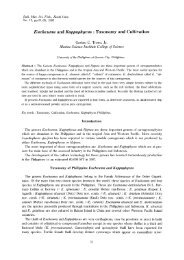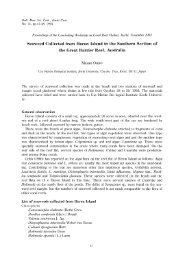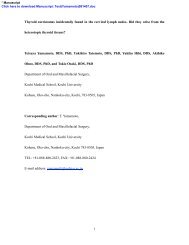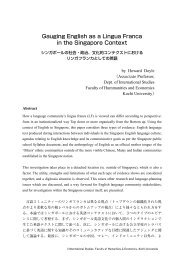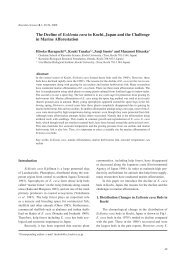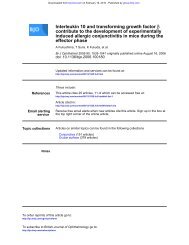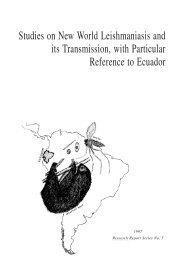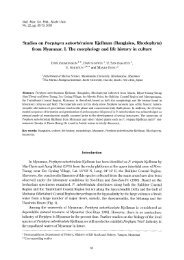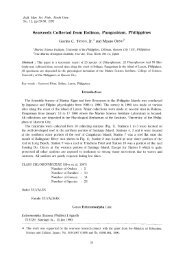Changes in soil bacterial community profiles associated with ...
Changes in soil bacterial community profiles associated with ...
Changes in soil bacterial community profiles associated with ...
You also want an ePaper? Increase the reach of your titles
YUMPU automatically turns print PDFs into web optimized ePapers that Google loves.
Soil <strong>bacterial</strong> communities reflect<strong>in</strong>g land degradation43where ABSit is the absorbance at 405 nm for the i-th carbon source at the time (t) and ABSct is the absorbance for thecontrol well, not <strong>in</strong>clud<strong>in</strong>g any carbon sources, at the time (t). This resulted <strong>in</strong> some negative values, which were regardedas 0 <strong>in</strong> the follow<strong>in</strong>g computation. The <strong>in</strong>crease <strong>in</strong> AWCD after this process was less than 2% of the AWCD for the sample.L<strong>in</strong>dstrom et al. (1998) po<strong>in</strong>ted out that rapidly and slowly metabolized carbon sources may contribute differently todiscrim<strong>in</strong>ation of <strong>soil</strong> microbial communities. Depend<strong>in</strong>g on AWCDs, such differential rates of utilization might result <strong>in</strong>success or failure <strong>in</strong> <strong>soil</strong> discrim<strong>in</strong>ation. To <strong>in</strong>vestigate this possibility, data sets on AWCD values of 0.2, 0.6, 1.0 and 1.4were statistically analyzed. Under our experimental conditions, the AWCD for each of the samples exceeded 1.5 after 80hours of the <strong>in</strong>cubation period, and started to converge. Therefore, the above AWCD values represented stages of colordevelopment.Data analysesThe one-way ANOVA to test the significance of deforestation on each <strong>soil</strong> characteristic and PCA to elucidate patterns ofvariation <strong>in</strong> <strong>soil</strong> <strong>bacterial</strong> <strong>profiles</strong> were performed us<strong>in</strong>g the computer software, SPSS 10.0.5J (SPSS Japan Inc., Tokyo). Tocompare the discrim<strong>in</strong>atory power of the profil<strong>in</strong>g methods, Wilk’s lambda statistic and its significance were determ<strong>in</strong>ed <strong>with</strong>the SPSS software. Wilk’s lambda is the most widely used statistic <strong>in</strong> determ<strong>in</strong><strong>in</strong>g the difference between multivariate datasets (Zar, 1999). If the means among compared groups for each variable are equal, Wilk’s lambda becomes 1. The moredifferent the data sets are, the closer Wilk’s lambda converges to 0.Redundancy analysis (RDA) and summariz<strong>in</strong>g the result as an RDA ord<strong>in</strong>ation diagram were performed us<strong>in</strong>g CANOCOfor W<strong>in</strong>dows 4.02 and CanoDraw 3.10 (Microcomputer Power, NY), respectively. RDA is a multivariate statistical techniqueto relate species distribution patterns and environmental factors <strong>in</strong> decreased dimensionality. Hence, this k<strong>in</strong>d of statisticaltechnique is categorized as the direct gradient analysis. RDA specifies statistically more or less significant environmentalfactors as gradients <strong>in</strong> relation to a species distribution pattern. RDA detects l<strong>in</strong>ear species distribution patterns aga<strong>in</strong>stsignificant environmental gradients (ter Braak & milauer, 1998). The significant environmental gradients are shown asvectors from the orig<strong>in</strong> of the ord<strong>in</strong>ation diagram. Thus, significant environmental gradients and some <strong>bacterial</strong> variableshave l<strong>in</strong>ear correlations. In the same diagram, the <strong>soil</strong> samples are located accord<strong>in</strong>g to their scores on the ord<strong>in</strong>ation axes.Regard<strong>in</strong>g each <strong>soil</strong> variable as the abundance of a species, RDA can be applied to analysis of distribution patterns of <strong>soil</strong><strong>in</strong>organic molecules (Odeh et al. 1991), sole carbon source utilization (Pankhurst et al. 2001) or <strong>soil</strong> biotic molecules(Blackwood et al. 2003). To determ<strong>in</strong>e the significance of the <strong>soil</strong> environmental factors, a Monte Carlo permutation test wasdone at 199 random permutations. Another Monte Carlo permutation test was done to exam<strong>in</strong>e the significance of extractedord<strong>in</strong>ation axes at 199 random permutations. In RDA, <strong>soil</strong> physico-chemical characteristics <strong>in</strong> Table 1 were designated as theenvironmental factors.RESULTSSoil characteristicsThe DEF and the BG <strong>soil</strong>s were easily dist<strong>in</strong>guished by color. The DEF <strong>soil</strong> was dull yellow brown (10YR 5/3), while the BG<strong>soil</strong> was reddish brown (5YR 4/8). The properties of the <strong>soil</strong>s are summarized <strong>in</strong> Table 1. Accord<strong>in</strong>g to the ANOVA, <strong>soil</strong>moisture content and pH significantly reflected the effects of deforestation at p=0.05. Deforestation was a marg<strong>in</strong>allysignificant source of variation of TC and MPN counts (0.05 < p < 0.10), and a less significant one of BD and TN (0.10 < p



